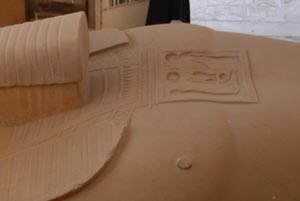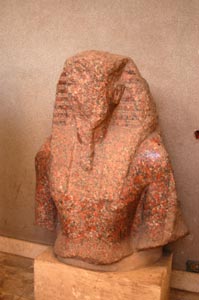










more photos
[ 1 ] [ 2 ]
site details
0730 -- 1600 summer
0730 -- 1700 winter
£E14 entry fee
£E7 entry student
£E10 camera
£E100 video camera
relevant links
history
New kingdom
18th Dynasty
Ramesses II
Colossus of Ramesses II
Despite its size, the work on the statue is very fine. The pleated details of Ramesses' kilt and belt and the nemes headress seem more suited to smaller, more finely detailed statues. At this size, it makes the statue seem very lifelike. Most people immediately recognize that the herculean task of smoothing and shaping some 40 feet of stone to this flesh-like smoothness is the work of a skilled artist, not the mass labor of slaves.

I was used to depictions of people in Egyptian art being strange-looking, with straight-on eyes and profile faces, legs and feet from the side, but shoulders seen from the front. It makes many people believe that the Egyptians did not care to accurately represent the human form -- or that they were not capable of realism in art. The subtle shaping of muscles and bone are obvious in this statue. The graceful scultping of the knee reminded me of of the fragments found at Tanis.
The carvings on the shoulder and chest are not intended as tattos, although they do remind me of them, but rather as labels -- in case we had any question who this gargantuan statue might belong to. They are inscriptions of his name and formal epithets to commend the king, in the form of this statue, to the gods.

There are a few other fragments of statues in the rectangular building, including some earlier statues in red granite, and a lumpy, oddly carved statue of the dwaft Bes, the god of fertility and childbirth. And, of course, a few helpful attendants...


one of the site attendants with the colossus,
and a faceless granite statue